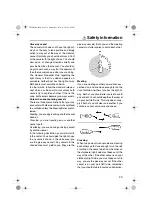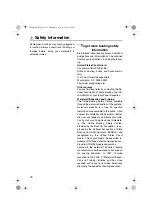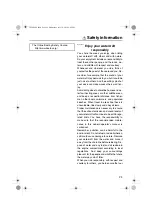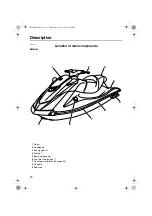
Safety information
13
EJU30812
Operation requirements
●
All riders must wear a U.S. Coast Guard
(USCG) approved personal flotation device
(PFD) that is suitable for personal water-
craft use.
●
Wear protective clothing. Severe internal
injuries can occur if water is forced into
body cavities as a result of falling into the
water or being near the jet thrust nozzle.
Normal swimwear does not adequately pro-
tect against forceful water entry into the rec-
tum or vagina. All riders must wear a
wetsuit bottom or clothing that provides
equivalent protection. Such clothing in-
cludes thick, tightly woven, sturdy and
snug-fitting apparel such as denim, but
does not include spandex or similar fabrics,
like those used in bicycle shorts.
●
Eye protection is recommended to keep
wind, water, and glare from the sun out of
your eyes while you operate your water-
craft. Restraining straps for eyewear are
made which are designed to float should
your eyewear fall in the water.
Footwear and gloves are recommended.
●
Helmets meeting Snell or DOT standards
are required for IJSBA-sanctioned races.
You must decide whether to wear a helmet
while you ride for recreation. You should
know that a helmet could help protect you in
certain kinds of accidents and that it could
injure you in others.
A helmet is designed to provide some head
protection. Although helmets cannot protect
against all foreseeable impacts, a helmet
might reduce your injuries in a collision with
a boat or other obstacle.
A helmet may have potential safety haz-
ards, as well. Falling into the water could
risk the chance of the helmet catching wa-
ter, commonly known as “bucketing”, and
the resulting strain on your neck could
cause choking, severe and permanent neck
injuries, or death. A helmet could also in-
crease the risk of an accident if it reduces
your vision or hearing, or if it distracts you or
increases your fatigue.
How should you decide if a helmet’s poten-
tial safety benefits outweigh its potential
risks for you? Consider your particular
riding conditions. Consider factors such as
your riding environment and your riding
style and ability. Also consider the likeli-
hood of traffic congestion, and the water
surface conditions.
If you decide to wear a helmet based upon
your riding circumstances, choose one
carefully. Look for a helmet designed for
personal watercraft use, if possible. Con-
sider a helmet meeting Snell or DOT stan-
dards. If you will be engaging in closed-
course competition, follow the helmet re-
quirements of the sanctioning organization.
●
Never operate the watercraft after consum-
ing alcohol or taking other drugs.
●
For reasons of safety and proper care of the
watercraft, always perform the pre-opera-
tion checks listed on page 57 before operat-
ing the watercraft.
1
USCG approved PFD
2
Wetsuit bottom
UF2M10E0.book Page 13 Wednesday, July 14, 2010 5:02 PM
Содержание VXS: VXR
Страница 12: ...General and important labels 7 UF2M10E0 book Page 7 Wednesday July 14 2010 5 02 PM ...
Страница 13: ...General and important labels 8 EJU35925 Other labels UF2M10E0 book Page 8 Wednesday July 14 2010 5 02 PM ...
Страница 107: ...UF2M10E0 book Page 3 Wednesday July 14 2010 5 02 PM ...
Страница 108: ...Printed in USA July 2010 0 2 1 CR YAMAHA MOTOR CORPORATION USA DIC183 ...
















































